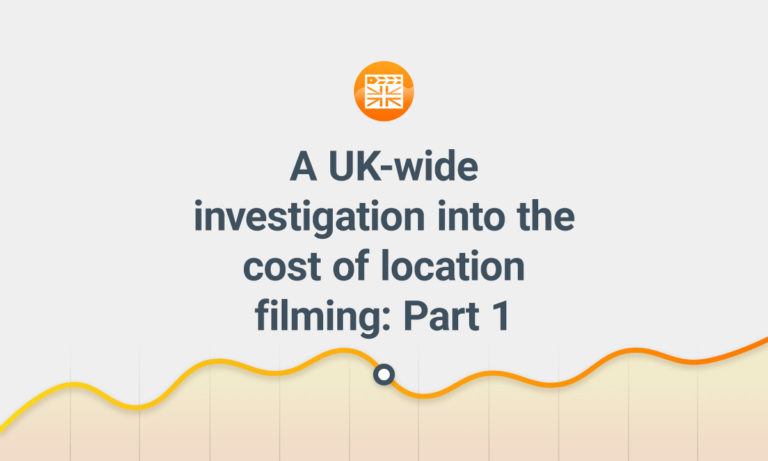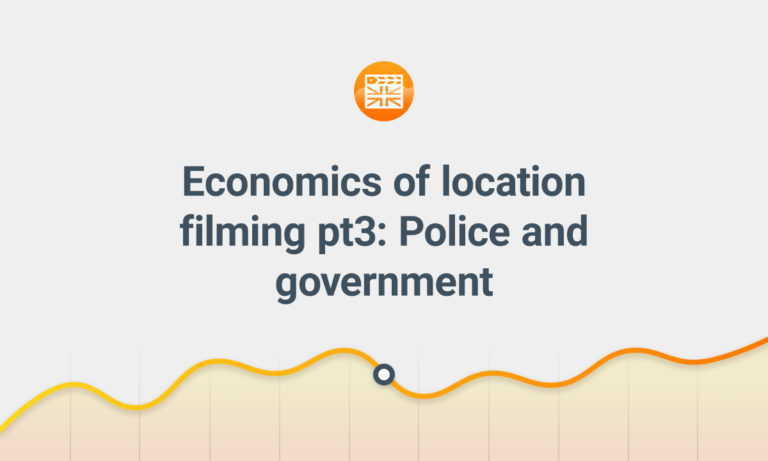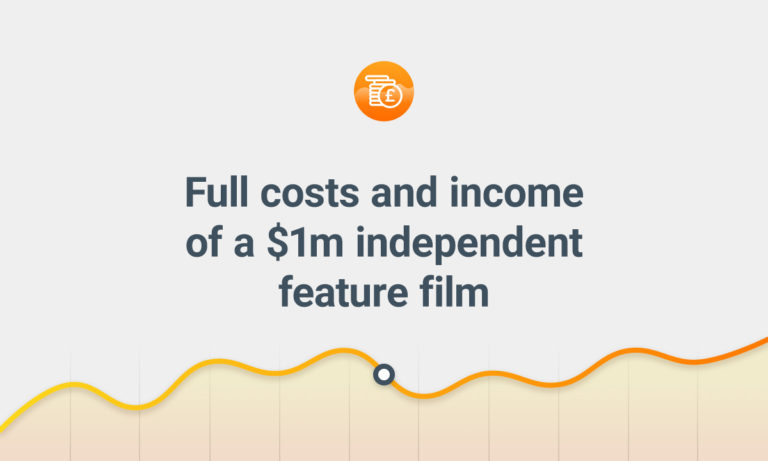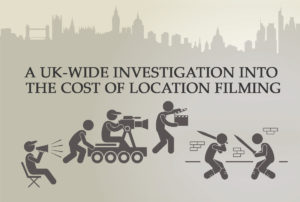 This week I am sharing more results from my investigation into the economics of location filming in the UK. I sent almost 800 UK public bodies a Freedom of Information request asking about the costs they charge, the income they receive and the services they provide to film and television shows which wish to shoot in their locations (more on my methodology here). Last week, I shared the data from local councils and this week I am turning to museums and galleries. In coming weeks I’ll look at the police force and other public bodies.
This week I am sharing more results from my investigation into the economics of location filming in the UK. I sent almost 800 UK public bodies a Freedom of Information request asking about the costs they charge, the income they receive and the services they provide to film and television shows which wish to shoot in their locations (more on my methodology here). Last week, I shared the data from local councils and this week I am turning to museums and galleries. In coming weeks I’ll look at the police force and other public bodies.
The UK has a large number of fascinating museums and galleries, many of which make perfect backdrops for film and television productions. Some make the location a part of the plot (such as the Natural History Museum in Paddington), while others just use it as a pretty place to blow up (such as the Greenwich Royal Naval College in Thor 2: The Dark World). No matter what’s shown on screen, behind the scenes the filmmakers need permission to use the site and their support in the actual filmmaking process.
A Million Pound business
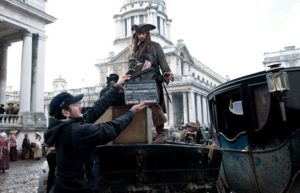 Of the nineteen museums and galleries I approached, all declared at least some income from film and television productions. The only museum-type body I spoke to which declared no income was the Northern Ireland Museums Council, due to the fact that they don’t own properties but just provide support and advice to Northern Irish museums.
Of the nineteen museums and galleries I approached, all declared at least some income from film and television productions. The only museum-type body I spoke to which declared no income was the Northern Ireland Museums Council, due to the fact that they don’t own properties but just provide support and advice to Northern Irish museums.
In 2014, these nineteen museums and galleries collectively raised £1,060,479 from location filming. I originally asked all organisations for their annual film / TV income over the past decade but some only provided data for four or five years. This was a mix of not having archived old records and as it would be too much work (the FOI Act requires bodies to spend up to 18 hours’ work to answer a request, so larger requests often need to be reduced in scope).
In the chart below I have included the figures for the ten highest earning museums and galleries, inflation-adjusted to 2016 pounds.
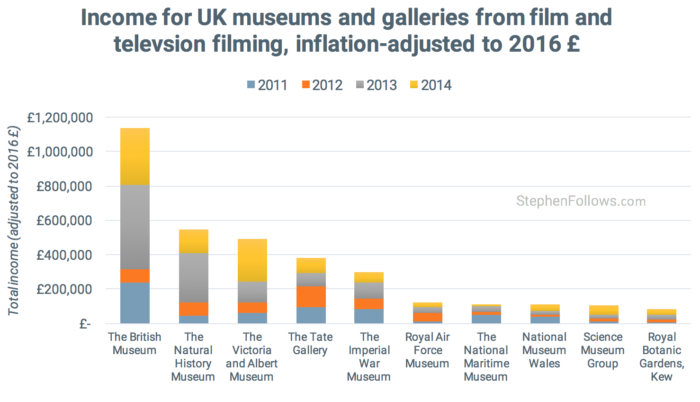
The British Museum on top
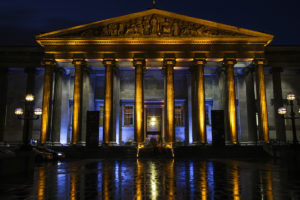 The British Museum is the UK’s most visited museum, with over five and half million visitors a year, and it also appears to be the UK’s highest earning museum from film and television productions. In just four years (2011-14) they raised £1,053,980 from location filming (these are raw figures, not inflation adjusted). Despite this large income stream, the museum must find it hard to plan as their income is rather erratic. For example, in 2012 they earned £69,933 whereas in the following year they earned £459,548, an over six fold increase year-on-year.
The British Museum is the UK’s most visited museum, with over five and half million visitors a year, and it also appears to be the UK’s highest earning museum from film and television productions. In just four years (2011-14) they raised £1,053,980 from location filming (these are raw figures, not inflation adjusted). Despite this large income stream, the museum must find it hard to plan as their income is rather erratic. For example, in 2012 they earned £69,933 whereas in the following year they earned £459,548, an over six fold increase year-on-year.
The cost of facilitating filming is not cheap, with the museum incurring almost a quarter of a million pounds worth of costs over the same four year period. This means that profit margin for the museum was an average of 24% (i.e. £1,053,980 income, minus £248,233 costs leaves £805,474).
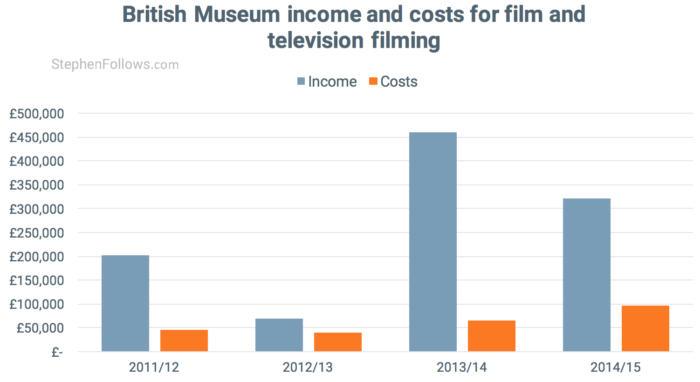
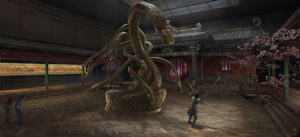 One ‘cost’ which is not captured in the chart above is the pain felt by museum staff when Hollywood plays fast and loose with historical details while filming on site. The British Museum’s increased income in 2013 is due in large part to the filming of Night at the Museum 3: Secret of the Tomb. Despite providing a healthy income for the museum’s coffers, museum staff are not too fond of the film due to its rather creative interpretation of history. In a special screening of the film for museum staff, audible gasps were heard during a scene which depicted people in Pompeii running from lava. The Times reported that one curator pointed out “There was no lava at Pompeii – Vesuvius erupted with a pyroclastic flow”. Sadly, this scene was not an isolated incident.
One ‘cost’ which is not captured in the chart above is the pain felt by museum staff when Hollywood plays fast and loose with historical details while filming on site. The British Museum’s increased income in 2013 is due in large part to the filming of Night at the Museum 3: Secret of the Tomb. Despite providing a healthy income for the museum’s coffers, museum staff are not too fond of the film due to its rather creative interpretation of history. In a special screening of the film for museum staff, audible gasps were heard during a scene which depicted people in Pompeii running from lava. The Times reported that one curator pointed out “There was no lava at Pompeii – Vesuvius erupted with a pyroclastic flow”. Sadly, this scene was not an isolated incident.
The Museum even has a part of their website dedicated to (very politely and patiently) explaining the film’s inaccuracies. Choice phrases include…
Sadly we don’t hold any dinosaur specimens as complete or impressive as the triceratops in the film.
In the film, the Kakiemon elephants have grown to the size of real elephants; fortunately for us they’re only 35cm tall in real life!
We don’t have Ankhmenrah’s tomb but we do have many sarcophagi in our Egyptian sculpture gallery.
Unfortunately we don’t have a nine headed snake demon cast in bronze.
Sir Lancelot is an incredibly popular character from the middle ages, one of the knights of King Arthur’s round table. However, he is a fictional character and not a part of the collection.
The next five highest earning museums and galleries
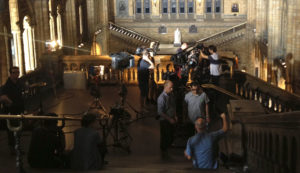 After the British Museum, the five museums and galleries which receive the most income from film and television productions are (shown with their 2008-14 income, inflation-adjusted to 2016 pounds)…
After the British Museum, the five museums and galleries which receive the most income from film and television productions are (shown with their 2008-14 income, inflation-adjusted to 2016 pounds)…
- £794,561 – The Natural History Museum
- £760,780 – The Victoria and Albert Museum (V&A)
- £609,772 – The Tate Gallery
- £445,891 – The Imperial War Museum
- £213,588 – The National Maritime Museum
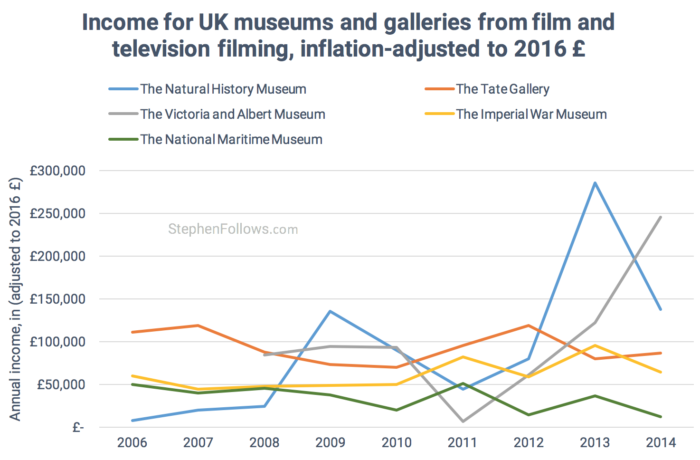
The Natural History Museum received a boost in 2013 due to prominently featuring in the film Paddington. This meant that its income in 2013 of £266,714 was way above other reported years (the next highest earning years were 2014 at £133,788 and 2009 at £112,271).
The costs to the museums are harder to compare than the income as each organisation reported back differently.
- The Natural History Museum provided a breakdown of costs over the past nine years. Staff overtime came to an annual average of just £1,546 (plus £314 for extra travel costs). The largest cost for facilitating productions were security officers (to supervise filming) and porters (to move furniture), which together came to £37,893. Overall, their costs amounted to just 7% of the income they received, providing a healthy profit to go into the museum’s general running costs.
- The Tate Gallery refused to answer, citing “commercial sensitivities“.
- The Victoria and Albert Museum (V&A) said “The staff time spent on facilitating these arrangements is not recorded separately, but we estimate it at 0.5FTE or c. £17k each year”
- The Imperial War Museum said “Much of the expense incurred for facilitating filming arrangements consists of staff time. For the press, collections and commercial teams, assisting with filming and footage for documentaries, news reports, and coverage of Museum events is part of regular staff output and the amount of time spent on this is not recorded separately. I am afraid this information cannot, therefore be provided“.
- The National Maritime Museum said “As the Museum does not record such very small costs on a case by case or even year by year basis this information is not available“.
The cost of location filming in the UK’s museums and galleries
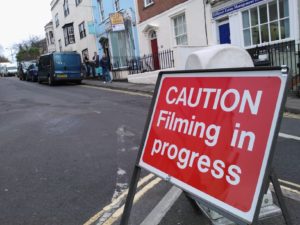 Below are a collection of costs I have discovered while conducting this research…
Below are a collection of costs I have discovered while conducting this research…
- The Museum of London usually charge £250 per hour of filming, and £50 an hour for a Curator.
- The Natural History Museum calculate their charges by crew size, with a minimum cost of £1,000 for all film and television productions. Below are the hourly costs by crew size…
- Fewer than five people = £350 per hour
- 6 to 10 = £400 per hour
- 11 to 20 = £600 per hour
- 21 to 30 = £700 per hour (plus staff costs)
- 31 to 80 = £1,100 per hour (plus staff costs)
- More than 80 people = £1,500 per hour (plus staff costs)
- They charge much less for student films (£100 per hour) but only for historical documentaries and there are a number of terms and conditions.
- The London Transport Museum charges commercial productions with fewer than 25 people (cast and crew) £500 per hour (with a two hour minimum), £1,500 for a half day (four hours) and £3,000 for a full day (eight hours). Productions with more than 25 people charge 25% more. This includes permission to film, free parking, a green room and onsite supervising staff. Non-commercial productions receive a 50% discount but don’t get use of the green room.
- When the BBC daytime TV show Flog It filmed at the Discovery Museum, it cost them £1,000.
- It’s common for locations to charge different rates for filming and non-filming (prep) days. For example, when Sherlock Holmes: A Game of Shadows filmed at the Old Royal Naval College, they charged £3,600 for their one day of filming but only £1,600 for each of the 13 days it took them to prep and strike the set.
- Interestingly, for many of the historical documentaries which shoot at the Royal Observatory in Greenwich and the National Maritime Museum, the cost of location filming also includes a ten-year worldwide license to use images of the artworks within.
Note: These are costs which have been charged to filmmakers in the past ten years and the prices and terms may have changed. In addition, some costs are calculated on a case-by-case basis and are therefore highly dependent on the particulars of the production. In short, don’t assume you can get these prices tomorrow.
Full breakdown of museum and gallery income
Below is the data I received from the museums and galleries which provided answers to my Freedom of Information requests. These figures are in GB pounds, are as provided and have not been adjusted for inflation. If an entry says ‘£-’ then this means that they did not receive any money that year from location filming, whereas ‘n/a’ means they did not provide data.
| '06 | '07 | '08 | '09 | '10 | '11 | '12 | '13 | '14 | '15 | 06-15 | |
|---|---|---|---|---|---|---|---|---|---|---|---|
| The British Museum | n/a | n/a | n/a | n/a | n/a | £202,939 | £69,933 | £459,548 | £321,561 | n/a | £1,053,980 |
| The Natural History Museum | £5,610 | £15,152 | £18,765 | £112,271 | £73,736 | £38,352 | £72,259 | £266,714 | £133,788 | n/a | £736,647 |
| The Tate Gallery | £81,748 | £90,252 | £69,762 | £60,984 | £57,543 | £82,054 | £107,769 | £74,370 | £83,940 | n/a | £708,422 |
| The Victoria and Albert Museum | n/a | n/a | £67,000 | £78,000 | £77,000 | £54,000 | £55,000 | £114,000 | £238,000 | n/a | £683,000 |
| The Imperial War Museum | £43,950 | £33,779 | £38,285 | £40,195 | £41,183 | £70,832 | £53,568 | £88,997 | £61,799 | n/a | £472,588 |
| The National Maritime Museum | £36,433 | £29,826 | £35,868 | £31,128 | £15,778 | £43,550 | £12,475 | £33,446 | £11,923 | £20,065 | £270,491 |
| National Museum Wales | £25,451 | £17,131 | £29,089 | £39,920 | £27,500 | £30,975 | £14,290 | £16,360 | £39,936 | n/a | £240,652 |
| Royal Air Force Museum | £3,100 | £2,030 | £8,064 | £7,762 | £23,616 | £9,850 | £44,231 | £32,633 | £25,825 | £6,186 | £163,297 |
| Royal Botanic Gardens, Kew | n/a | n/a | £13,655 | £4,040 | £11,790 | £3,660 | £17,553 | £24,556 | £33,038 | £10,758 | £119,050 |
| Science Museum Group | n/a | £1,750 | £2,400 | £- | £2,000 | £8,029 | £14,629 | £21,920 | £53,550 | £4,952 | £109,230 |
| The National Portrait Gallery | £3,250 | £3,062 | £8,422 | £1,375 | £1,200 | £1,350 | £5,200 | £2,755 | £7,000 | £36,188 | £69,802 |
| National Museums of Northern Ireland | n/a | n/a | n/a | £2,550 | £5,700 | £2,100 | £4,150 | £19,880 | £10,500 | £6,460 | £51,340 |
| Museum of London | n/a | n/a | £5,522 | £995 | £2,853 | £4,638 | £3,385 | £8,809 | £7,072 | £8,100 | £41,372 |
| London Transport Museum | n/a | £- | £- | £- | £- | £- | £4,000 | £7,000 | £22,000 | £1,500 | £34,500 |
| National Museums of Scotland | £1,550 | £4,198 | £2,090 | £3,191 | £2,150 | £950 | £485 | £5,092 | £1,850 | £6,475 | £28,031 |
| National Museums Liverpool | £2,756 | £1,018 | £- | £1,200 | £- | £1,569 | £3,235 | £5,949 | £5,416 | £6,510 | £27,652 |
| Royal Armouries | n/a | n/a | £1,700 | £1,000 | £1,150 | £4,602 | £3,950 | £4,415 | £1,991 | n/a | £18,808 |
| Tyne and Wear Archives and Museums | £100 | £300 | £3,091 | £2,265 | £925 | £5,722 | £200 | £1,700 | £240 | £650 | £15,192 |
| National Galleries of Scotland | n/a | n/a | n/a | n/a | n/a | n/a | £2,805 | £1,700 | £1,050 | £- | £5,555 |
Notes on the economics of location filming
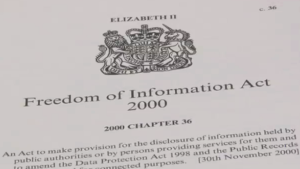 Last week I shared part one of this multi-part research project. That article included details of the Freedom of Information Act, my methodology and a number of notes and caveats. It’s worth having a read of them if you’re planning on using today’s research as most also apply here.
Last week I shared part one of this multi-part research project. That article included details of the Freedom of Information Act, my methodology and a number of notes and caveats. It’s worth having a read of them if you’re planning on using today’s research as most also apply here.
Unless stated otherwise, figures are raw, as provided and exclusive of VAT. When looking at figures over time, or when providing multi-year totals, I have sometimes adjusted for inflation to bring all figures to 2016 UK pounds. In all such cases I have explicitly mentioned the adjustment.
In the analysis above I did not include Historic Environment Scotland as they’re not strictly a museum or gallery. They describe themselves as “the lead public body set up to investigate, care for and promote Scotland’s historic environment“. Between 2006 and 2015, they charged film and television productions £488,279 at a cost of £58,053, meaning they had a profit margin of 91%.
Epilogue
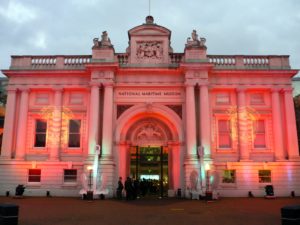 I half suspect the folk at the National Maritime Museum don’t like me very much, judging by the manner in which they provided their information.
I half suspect the folk at the National Maritime Museum don’t like me very much, judging by the manner in which they provided their information.
Every other organisation I spoke to during this research replied via email, usually providing similar annual figures or digital attachments with breakdowns. However, the National Maritime Museum decided to print off every invoice they have relating to location filming for much of the past decade and send them to me physically.
I hope this approach of sending physical copies of all records was due to a desire to be complete rather than for any other reason. I actually quite preferred it as (a) I was able to reduce the FOI demands on the staff and (b) I got granular level detail as to location costs on their sites. I will be sharing some of the insights in a future article looking at location costs for certain large productions. Stay tuned, folks.

